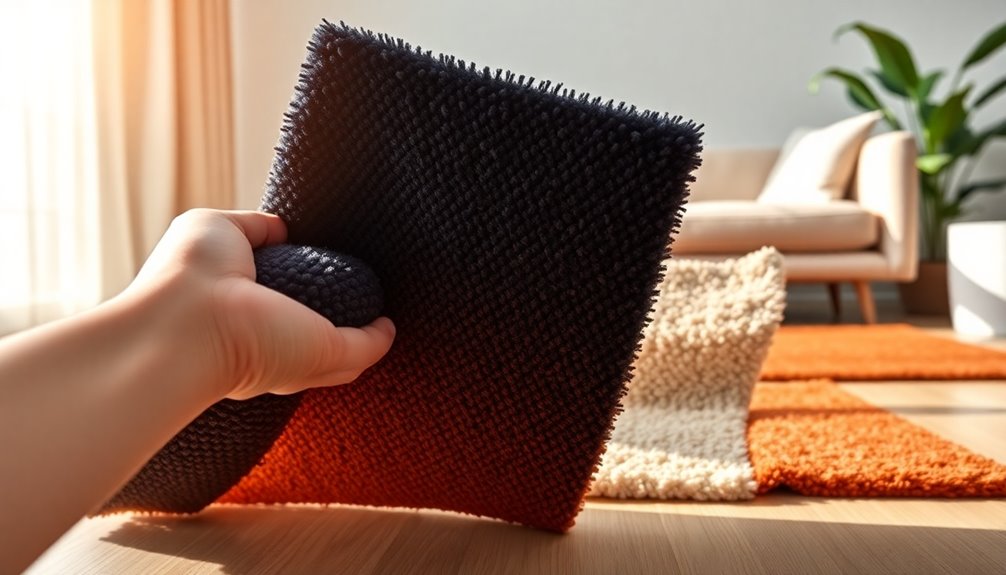Choosing the right carpet colors for your home starts with considering the room's purpose and mood. Think about what vibe you want to create—muted tones for relaxation or vibrant colors for energy. Match your carpet with existing furniture and wall colors for a cohesive look. Remember that lighting can change how colors appear. For high-traffic areas, darker shades or patterns can effectively hide stains, while lighter hues add warmth in low-traffic spaces. Testing samples in your own home will help you make the best choice. Keep going to explore more tips for a successful selection!
Key Takeaways
- Consider the room's purpose and desired mood when selecting carpet colors, opting for muted tones for relaxation and vibrant hues for lively areas.
- Match carpet colors with existing furniture and wall shades, ensuring warm tones complement warm decor and cool tones match cool accents.
- Test color swatches in your home to see how natural and artificial lighting affects their appearance throughout the day.
- Choose darker colors or patterns for high-traffic areas to effectively hide stains, while lighter shades work well in low-traffic spaces.
- Opt for neutral colors for versatility and better resale value, while incorporating playful colors in children's rooms or accent spaces.
Key Considerations for Carpet Colors
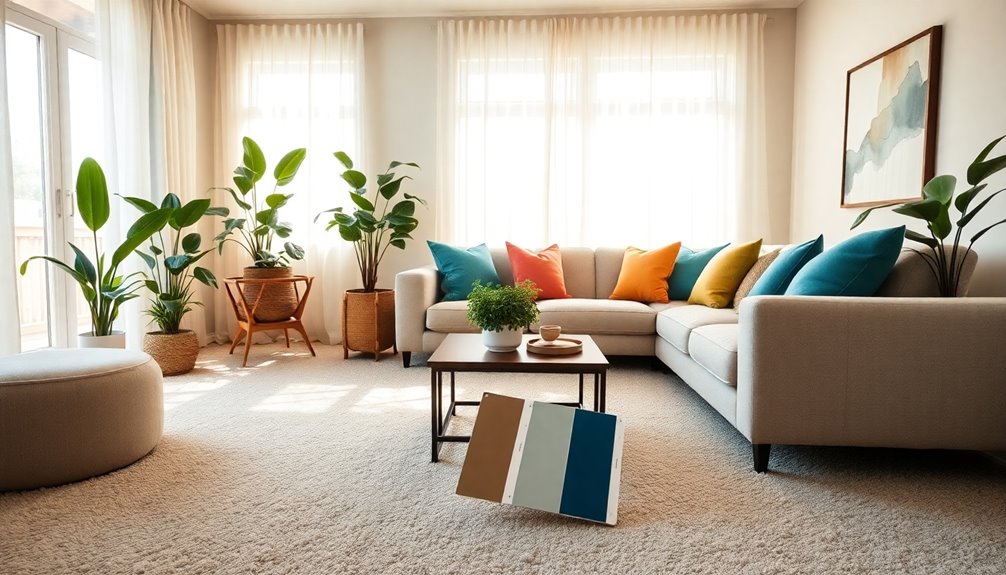
When you're choosing carpet colors for your home, it's essential to contemplate the room's purpose and the mood you want to create. For instance, muted colors work well in bedrooms for relaxation, while vibrant hues can stimulate conversation in living rooms.
Always match your carpet color choice with existing furniture and wall colors—warm tones with warm and cool tones with cool. Pay attention to lighting; natural light brightens colors, while artificial light can alter their appearance.
In high-traffic areas, consider darker colors or patterns to hide stains and spills, whereas lighter shades suit low-traffic spaces. Always test color swatches in your home to see how they interact with your room's lighting and decor before making a final decision. Additionally, incorporating multi-functional furniture can enhance the overall design and functionality of the space, complementing your chosen carpet colors.
Popular Color Choices
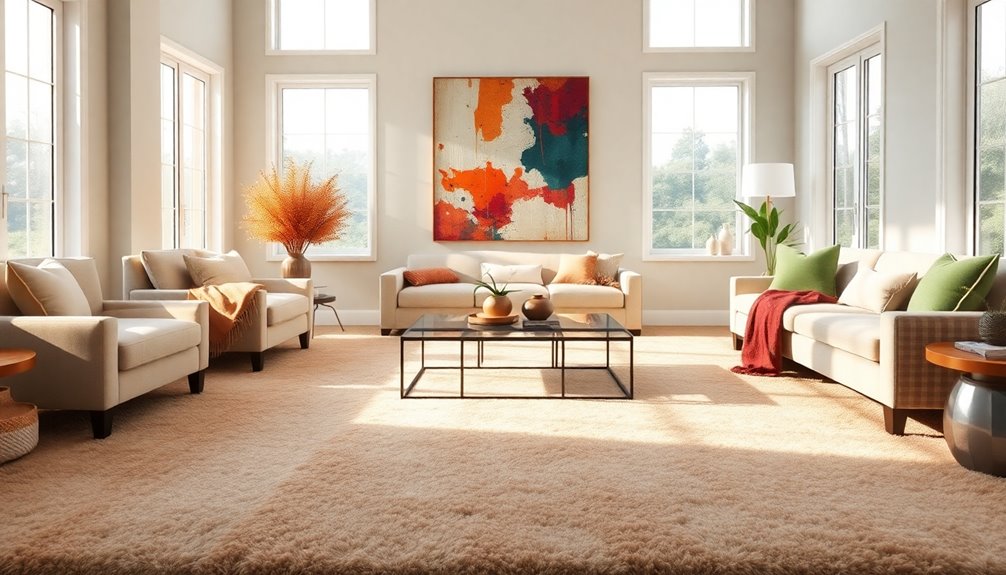
Selecting the right carpet color can considerably enhance your home's overall aesthetic. Currently, gray and beige are the most popular carpet choices, offering versatile neutral carpet colors that suit various styles.
If you're looking for something practical, dark colors like charcoal and dark brown can effectively hide stains, making them great for families and pet owners.
On the other hand, light colors, such as beige and ivory, create warmth and can make spaces feel larger, although they require more maintenance.
Warm neutrals like cappuccino and tan are favored for their timeless appeal.
For a playful touch, consider vibrant colors like shades of blue and green, perfect for children's rooms or as accent carpets in your home.
Patterns and Textures
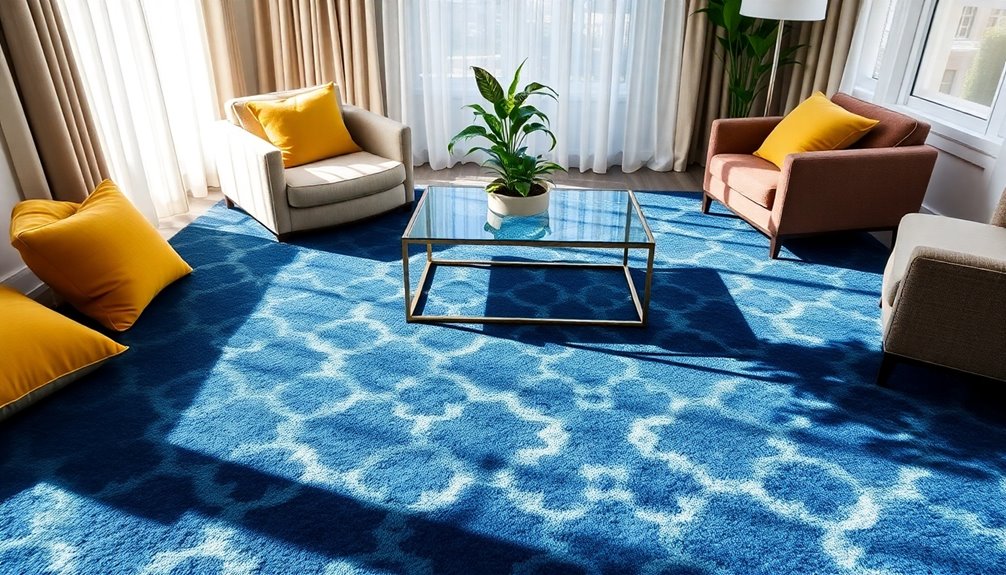
Carpet patterns and textures can transform a room, adding visual interest without overwhelming your decor.
When selecting the right style, consider how patterns and textures enhance the character of your space. Here are some options to explore:
- Subtle patterns that complement existing design elements
- Unique textures, like friezes or cut and loop styles, for added depth
- Flecked colors in Berber styles to camouflage dirt
- Intricate patterns for a distinctive, elevated look
- The carpet fiber material, whether natural or synthetic, affecting softness and durability
Lifestyle and Maintenance Factors

Although you might be drawn to a specific color for its aesthetic appeal, lifestyle and maintenance factors play an important role in your carpet choice.
If you have kids or pets, opt for darker colors; they effectively hide stains and dirt while creating a cozy atmosphere. On the other hand, light-colored carpets can show dirt more easily, requiring frequent cleaning and regular upkeep, which isn't ideal for high-traffic areas.
Midtone colors strike a balance, being more forgiving with debris. Consider selecting stain-resistant carpet materials like nylon for enhanced durability and easier cleaning.
Ultimately, regardless of the color you choose, regular maintenance is vital to guarantee your carpet remains both aesthetically pleasing and functional over time.
Practical Selection Tips
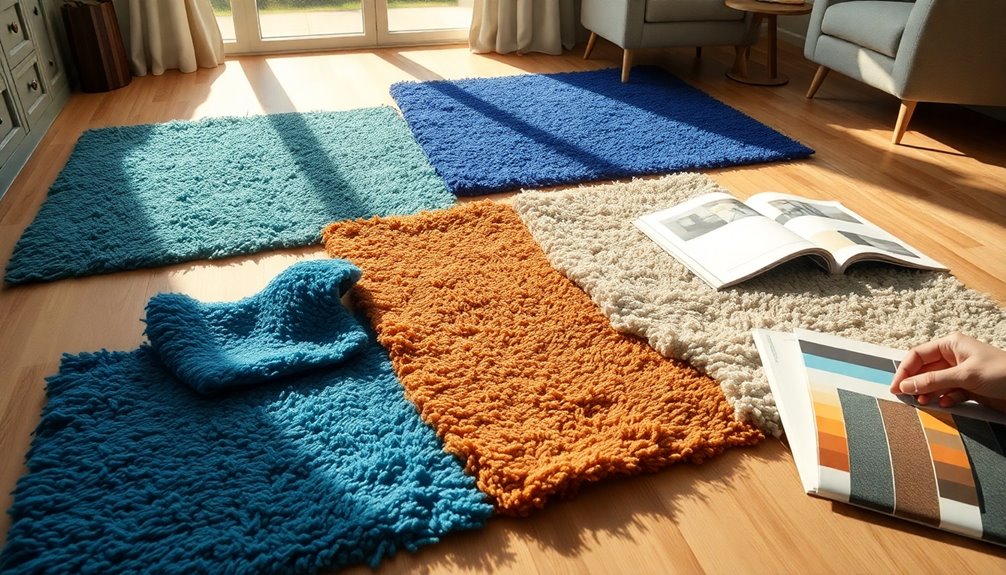
When you're choosing the right carpet for your home, it's essential to reflect on the room's purpose and the emotions different colors can evoke.
Start by testing carpet samples in the intended space, considering how light affects their appearance throughout the day. To make a smart selection, keep these tips in mind:
- Choose neutral colors for versatility and resale value.
- Opt for a light gray carpet in low-traffic areas for a fresh look.
- Use darker shades or patterned carpets in high-traffic areas to disguise dirt.
- Coordinate carpet colors with your existing décor for harmony.
- Consider the room function; muted tones can promote relaxation in bedrooms. Additionally, incorporating natural elements in your decor can enhance the overall aesthetic when selecting carpet colors.
Frequently Asked Questions
Should Carpet Be Lighter or Darker Than Walls?
When deciding whether your carpet should be lighter or darker than your walls, consider the mood you want to create.
Lighter carpets can make a room feel more spacious and bright, while darker carpets add warmth and depth. Aim for at least a two-tone contrast for visual interest.
Also, think about the room's function; darker carpets can hide dirt better in high-traffic areas, while lighter options can enhance natural light.
How to Choose the Right Color for Carpet?
Choosing the right carpet color involves considering your space's overall feel and function.
Start by thinking about the room's focal point and existing decor; you want harmony. Grab some swatches to see how colors play with your lighting.
Aim for a balance between your wall colors and carpet; one should be neutral.
Finally, factor in foot traffic—darker shades work better for busy areas, while lighter colors can open up the space.
What Carpet Color Goes With Everything?
Choosing a carpet color that goes with everything is like finding a classic white shirt—it's versatile and timeless.
Neutral shades like beige, gray, or greige work beautifully with various decor styles, allowing you to switch up accent colors without a hitch. Light tones create warmth, while mid-tone grays add sophistication.
If you prefer something darker, charcoal can ground your space.
What Is the Most Popular Carpet Color Right Now?
Right now, gray and beige are tied as the most popular carpet colors.
They're incredibly versatile, fitting into various design styles effortlessly. If you're looking for something that blends well, consider greige, which combines both tones.
For practicality, dark colors like charcoal work well in high-traffic areas, hiding stains effectively.
If you want warmth and space, light shades like ivory are fantastic options.
Don't forget, vibrant colors can add a fun touch to specific rooms!
Conclusion
Choosing the right carpet colors is like painting your home's personality; it sets the mood for every room. By considering your lifestyle, maintenance needs, and personal style, you can weave warmth and comfort into your space. Remember, the perfect hue can transform a dull room into a vibrant haven. So, trust your instincts, explore patterns, and let your imagination dance across the fibers. With the right choice, your home will feel as inviting as a warm embrace.
